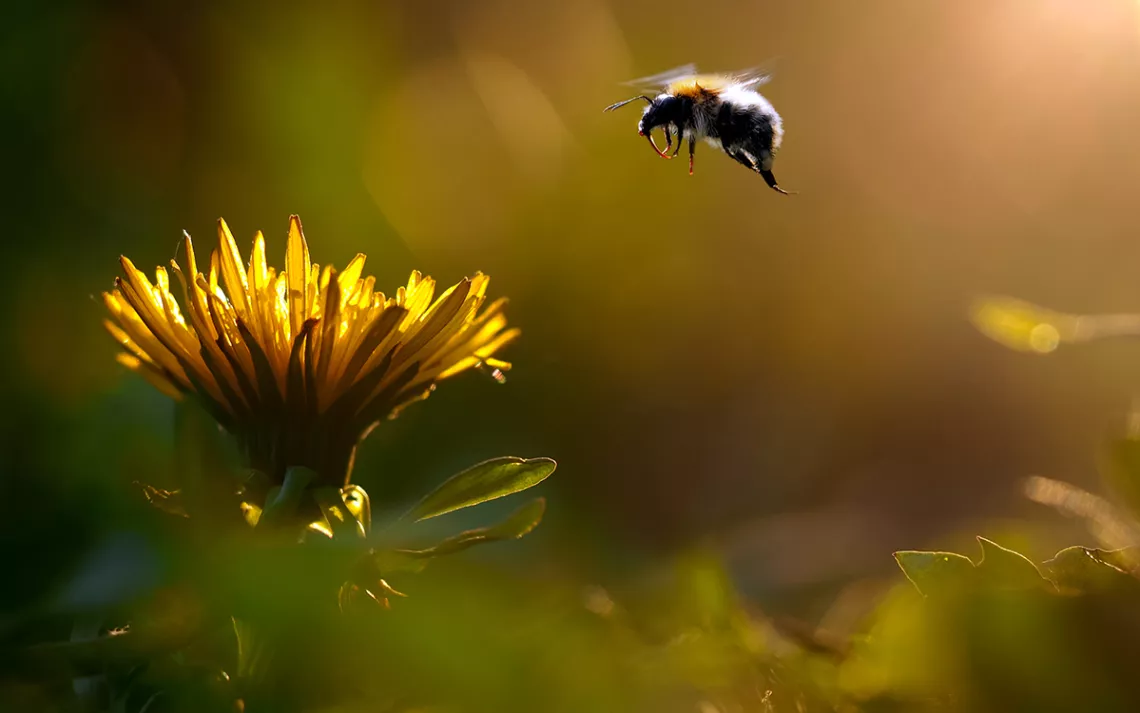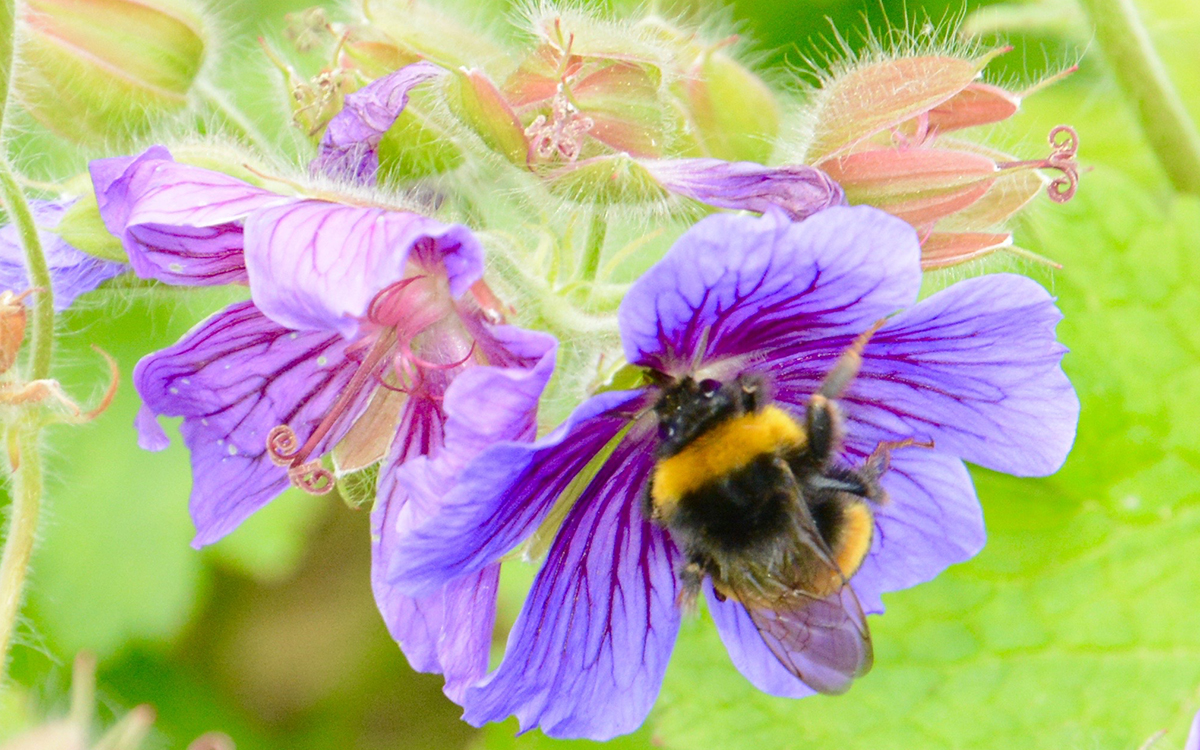Are Bumblebees Going Extinct?
Plenty of bad news, plenty of hope

Image by Kozorog | iStock
Bumblebees are among the most effective pollinators—they’re big and they’re fuzzy, which means a lot of pollen sticks to them, and they buzz so vigorously that they knock more pollen out of flowers than other pollinators like honeybees do.
They are also very threatened by climate change, according to a report published today in Science, which found that the habitat where most species are found has narrowed considerably in recent decades. Between the baseline period (1901 to 1974) and the time when climate change began to have an effect on weather patterns (2000 to 2015), the probability that bumblebees would be found at a site in North America declined by 46 percent. In Europe, that probability declined by 17 percent.
“It was the weirdest thing ever,” says Jeremy Kerr, a biologist at the University of Ottawa and a coauthor of the report, along with Peter Soroye, a PhD candidate at the university, and Tim Newbold, an ecologist at University College London. "We were going over our numbers, and we realized that actually what we were looking at over the course of half a generation of humans was the progressive mass extinction of a taxom. This is a whole group of species. It's showing a decline of around 30 percent, in less than 20 years. I mean, it's an astonishing rate of change.”
The report builds on previous research that Kerr and other scientists have done with a massive dataset that combines information from more recent wildlife surveys with location data collected from specimens held in the archives of natural history museums. Because of the limitations to that approach (much of the data is concentrated around sites in North America and Europe that were frequently visited by entomologists and insect collectors, for example) other scientists say that this kind of data is suited to find correlations, rather than make conclusions. “We need details; we need examples of species that have shown changes in distribution and why,” wrote Sydney Cameron, an entomologist at the University of Illinois, when asked her opinion of the new report. “We need data from populations within species, showing how some might have shifted while others have remained.”

Bombus terrestris on flower | Photo courtesy of Jeremy Kerr
Because most insect spotters and collectors (both past and present) are disproportionately drawn to the flashiest specimens, the bumblebee is the rare pollinator that does consistently show up in natural history archives, and that attracts fans who use citizen science tools like Bumblebee Watch. Trying to collect similar data on sweat bees, for example, would be much more difficult. “They're really cute,” says Soroye, of bumblebees. “People enjoy looking for them. And so we're able to have a huge amount of information through space and time on them to relate to climate extremes or habitat loss.”
Bumblebees may be particularly vulnerable to the temperature extremes that climate change is causing, Kerr says. “If you trace their lineage back a few tens of millions of years and ask the question ‘Where did bumblebees come from?,' the answer is that bumblebees come from places that were somewhere between chilly and temperate, but definitely not tropical. They didn't evolve under warm conditions.”
Kerr and Sorye are also studying the distribution of butterflies, another group of pollinators that are even better represented in natural history collections. “They're completely different,” says Kerr, of the butterflies. “They evolved under tropical conditions. It could be that bumblebees are responding really badly to climate change as a reflection of their evolutionary inheritance.”
Even a few hot days a year can be deadly to bumblebee populations in the long term. When temperatures rise to about 100 degrees Fahrenheit, many bumblebee species, says Kerr, "basically kind of go punch drunk.” They stop gathering pollen and expend their energy trying to fan the colony and keep it cool.
Like other species that are vulnerable to climate change, bumblebees are moving toward the poles and into colder climates. But they aren’t doing it quickly enough to stay ahead of their declining range. For every one instance that Soroye and Kerr found of bumblebees appearing in a new location, they found eight instances of them disappearing entirely from others.
Not every place is losing bumblebees at the same rate. Because they’re ground-nesters, bumblebees are particularly vulnerable to pesticides and any form of land management that disturbs or removes rotten logs, fallen leaves, and shrubs and shade trees. The disparity between relative bumblebee declines in Europe and North America could mean that European bumblebees had already lost more territory to development and agriculture and thus had less to lose—or it could be a sign that the way that land is managed in European countries is preventing further losses.
Soroye and Kerr plan to use the data to calculate the effects of climate change on the range of other species—and to look more closely at sites where bumblebees have managed to hang on or expand their range despite the changing weather patterns brought by climate change. Soroye thinks these sites could have “microrefugia”—shaded, undisturbed spots that bumblebees can use to build colonies, and to retreat to during a heat wave.
In a review of the global status of bumblebees published in the Annual Review of Entomology, Cameron and Ben M. Sadd, a biologist at Illinois State, go even bigger, calling for long-term field and laboratory studies—similar to the work that the European Union has put into assessing the effect of neonicotinoids on honey bees—that might be able to conclusively explain why the presence of bumblebee species in some areas is increasing, even as it declines in others. As far as climate change is concerned, Cameron recommends in-depth long-term studies of specific habitats. “At this early stage in our awareness of climate effects on bees,” writes Cameron, “we need more studies like those of David Inouye and Jessica Forrest, who have been working on alpine floral distribution and seasonal changes in flowering.”
Kerr is also excited for research to head in this direction. “This is the thing we really live for,” he says. “If you really get down to it, we're studying the end of the world. What we would really like to do is not be doing that. But if we have an answer to the question, “Why is this decline happening?” then we can shift from studying something awful to pointing out that there can be hope. That is a valuable thing for people who are in our line of work.”
 The Magazine of The Sierra Club
The Magazine of The Sierra Club



